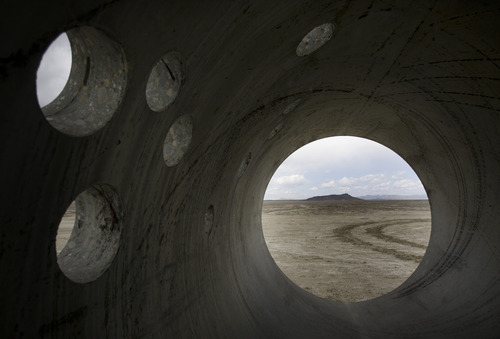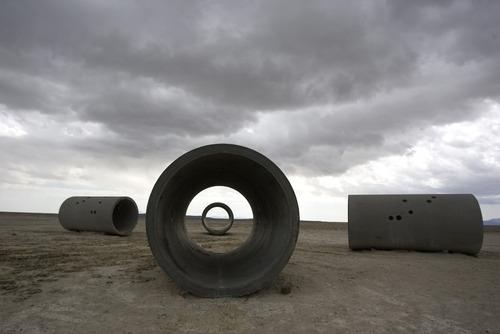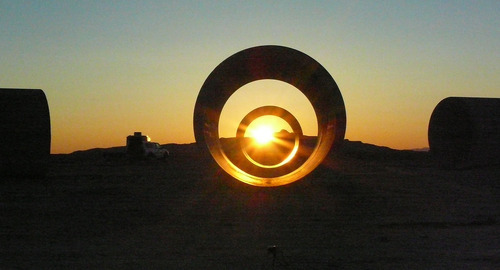This is an archived article that was published on sltrib.com in 2012, and information in the article may be outdated. It is provided only for personal research purposes and may not be reprinted.
Nancy Holt says she always has been interested in "seeing sight" — exploring how people view the world, and the ways that view can be altered.
"With my work, I'm kind of setting up situations where you're questioning your sight," Holt, 74, said in a phone interview this week from her studio near Santa Fe, N.M. "Even within the view that a video would give you, which is a limited view, I'm further investigating that to call attention to that. It's so easy to lose yourself in a film. It takes over the believability factor."
Holt's view of the world — and her view of how we view it — is highlighted in "Nancy Holt: Sightlines," a new exhibit opening Friday at the Utah Museum of Fine Arts.
The exhibit chronicles Holt's early work, from 1966 to 1980, when she was at the forefront of sweeping new movements in the art world. Most famously, Holt was a leading figure in the "Land Art" movement, site-specific works that took art of the gallery and put it in the wide-open spaces of the American West.
She was among the first video artists and a pioneer in art photography. She also writes "concrete poetry," in which the typography and placement of the words on the page are as much a part of the art as the words themselves.
"I work in many mediums, but there's a consistency throughout," she said.
Holt's most famous work is a familiar one to Utahns: "Sun Tunnels," the installation she planned and constructed in Utah's west desert from 1973 to 1976.
The idea behind "Sun Tunnels" is, like Holt's video works, about the way we see what's out there. The artwork consists of four 18-foot-long concrete tubes, arranged to catch the rising and setting sun on the summer and winter solstices.
"When you're out in a place like 'Sun Tunnels,' the desert is so vast, so overwhelming," Holt said. "The tunnels orient you out in space and frame the view. It brings the landscape back to human scale."
Holt's life as an artist changed, she said, the day in 1968 when she landed at the Las Vegas airport with fellow artists Robert Smithson and Michael Heizer.
"The airport was out in this flat desert area, so I experienced the space of the West. I was overwhelmed with it," Holt said. "It seemed to me that I had this Western space that had been within me. That was my inner reality. I was experiencing it on the outside, simultaneously with my spaciousness within. I felt at one."
Smithson and Holt, who were married from 1963 until his death in a plane crash in 1973, collaborated on film projects — such as the 1969 short "Swamp" — and both helped propel the land-art movement, manifested in Holt's "Sun Tunnels" and Smithson's landmark work, "Spiral Jetty" (1970), at the north end of Utah's Great Salt Lake.
"It's really hard to draw a connection on a formal level, on an aesthetic level" between Holt's work and Smithson's, said Alena Williams, who curated the "Sightlines" show (first displayed in 2010 at New York's Columbia University) and wrote the companion book. "His impetus is different from hers. His is more out of a geological time. Hers is more out of time-based media — cyclical time [such as the solstice], that puts a viewer in a specific space."
Holt got the idea for "Sun Tunnels" in 1973 and looked in New Mexico and Utah for a viable location. "I needed a very open, vast space with nothing close by," she said. "Just vistas in every direction."
She and Smithson had bought a small parcel in Utah's west desert in 1971, and she bought more land out there in 1975. "I own a butte with a fabulous 360-degree view," she said, about five miles from the "Sun Tunnels" site, near the ghost town of Lucin. She also bought land at the base of Pigeon Mountain, five miles east of Lucin.
She lived in Salt Lake City for a year in 1975, renting a studio from the late artist Lee Deffebach while she completed "Sun Tunnels." Holt and about 30 other people celebrated the piece's "opening" on June 21, 1976, marking the summer solstice.
Because of the remoteness of "Sun Tunnels" — a four-hour drive from Salt Lake City — it's more often experienced through images, such as the film "Sun Tunnels" that Holt shot during the work's construction.
"Documentation has always been a big part of land art," said Whitney Tassie, the new curator of contemporary art at UMFA. "You can't move the sculpture into the gallery space."
The success of "Sun Tunnels," Williams said, led to Holt receiving commissions for other site-specific work in more populated areas — coinciding with the start of the "Public Art" movement, when architects and developers were planning art installations with their properties. Williams cites Holt's installation "Dark Star Park" (1979), which was part of an urban-renewal project in Rosslyn, Va., as an example of that shift.
On Saturday, Oct. 20, Holt will meet any interested observers at "Sun Tunnels" at sunset. There's no formal program, and anyone going must arrange transportation. Still, Williams said, "it's rare to visit a 'Land Art' work with the artist present."
Holt promises it will be worthwhile. "There are quite a few things to see along the way," she said. "It's an interesting trip."
Nancy Holt, back in Utah
"Nancy Holt: Sightlines" is an exhibit of the artist's work from 1966 to 1980 — including film, video, concrete poetry and photographs. The exhibit is organized by the Miriam and Ira D. Wallach Art Gallery, and curated by Alena Williams.
Where • Utah Museum of Fine Arts, 410 Campus Center Drive, University of Utah, Salt Lake City
When • Oct. 19 to Jan. 20
Related events
The Utah Museum of Fine Arts has organized several free events in connection with the "Nancy Holt: Sightlines" event.
Thursday, Oct. 18, 6 p.m. • An opening celebration at UMFA, featuring a lecture by Holt and a chance to be the first to see the exhibit.
Saturday, Oct. 20, 6 p.m. • Holt will visit "Sun Tunnels," her installation in Utah's west desert, at the optimal time to view it: near sunset. There is no formal program, and participants must arrange their own transportation. Visit UMFA's website, http://www.umfa.utah.edu, for directions, precautions, travel tips and recommended clothing.
Tuesday, Oct. 23, 4 p.m. • Art Talk: "Sun Tunnels: Construction/Reconstruction," with a screening of Holt's film "Sun Tunnels," followed by a talk with professors Hikmet Sidney Loe (of Westminster College) and Paul Stout (of the University of Utah) about their 2010 reconstruction work on the artwork.







